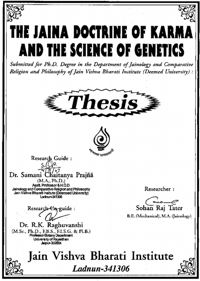Ghāti And Aghāti Karma
It is obvious that karma obscures, obstructs, cripples and distorts the innate characteristic qualities of the pure soul. But all the eight main species described above do not possess the same degree of potency of defilement.
The eight species are thus divided into two groups:
(1) ghāti karma - destroying karma.(1) Ghāti karma
(2) aghāti karma - non-destroying karma.
(2) Aghāti KarmaThis group of karma cripples and distorts the innate qualities of the soul. The ghāti karma are:
Ghāti karma are further divided into:
- knowledge obscuring karma.
- intuition obscuring karma.
- deluding karma.
- energy obstructing karma.
(a) serva ghāti - fully destroying.
(a) Serva Ghāti
(b) deśa ghāti - partially destroying.[6]
(a) delusion of truth.
(b) delusion of conduct.(b) Deśa ghātiPredilection for and faith in truth (samyaktva) which is the omniscience, the innate characteristic of soul, is destroyed by serva ghāti truth - deluding karma (mithyātva). Delusion of truth (mithyātava) is the root cause of all the evils, and the worldly state of existence of soul and whatever miseries, there were in the career of a soul are ultimately due to it. Otherwise, in its true sence it has no beginning and therefore is eternal. Its beginninglessness of the existence cannot be questioned because it is an ultimate fact. It is there. It is also the primary cause of the new bondage of karma. Until and unless its potency is destroyed or at least subsided sufficiently, the soul is unable to transcend the cycles of rebirth and continues its worldly state. The strong types of passions (anger, ego, deceit and greed) x (anantānubandhī, apratyākhyānī, pratyākhyānī) (totaling twelve) also fully cover their object.
Thus, there are twenty sub-types which are obscuring completely. They obscure their respective objects completely. But this does not mean that their is absolute lack of predilection for truth or the capacity to cognize it. If that were the case, the soul would loss its soulness and become a non-soul. Even as the densest and darkest cloud cannot completely obfuscate, the sun, exactly so the karma cannot obscure the total ability of knowledge of the truth.
Partially obscuring (deśa ghāti) sub species are twenty five viz. the remaining four knowledge covering, three sub-types of intuition - covering, four mildest type of passions, nine types of quasi-passions:
- joy-laughter (hāṣya)
- sorrow (śoka)
- sensuous pleasure (rati)
- ennui in self discipline (arati)
- fear (bhaya)
- disgust (jugupṣā)
Aghāti karmas do not obscure any fundamental quality of the soul, but force the soul to continue its worldly existence and prevents emancipation. Four aghāti karmas are:
The feeling producing karma has two sub-types:
- feeling producing.
- body making.
- status determining.
- life span determining.
- sātā vedanīya - pleasure producing.
- asātā vedanīya - pain producing.
Nāma karma is concerned with body making and causes the individual diversities. It has the largest number of sub-types (103) accounting for various forms of embodied existence. For example gati nāma karma determines the species of living organism viz.:
- sub animal such as plants, water etc. and animal world.
- human being
- celestial beings
- denizens of hell.
In the same way various functions of organ building, joint building, structure building commensurate with the species of organisms are allotted to other sub-types of this karma.
Gotra karma determine the diversities of racial, social and genealogical status and has two sub-types:
- high status,
- low status.
Lastly the Āyuṣya (life span determining) karma has four sub-types which are identical to gati-nama-karma as said above viz.
Thus remaining 120-20 serva-ghāti-25 deśa ghāti = 75 karmas uttarprakṛtis do not effect the quality of soul and called Aghāti karma.
- sub-animal - such as plants, water etc. and animal world.
- human life
- celestial life
- hellish life.[7]
 Prof. Dr. Sohan Raj Tater
Prof. Dr. Sohan Raj Tater
 Doctoral Thesis, JVBU
Doctoral Thesis, JVBU